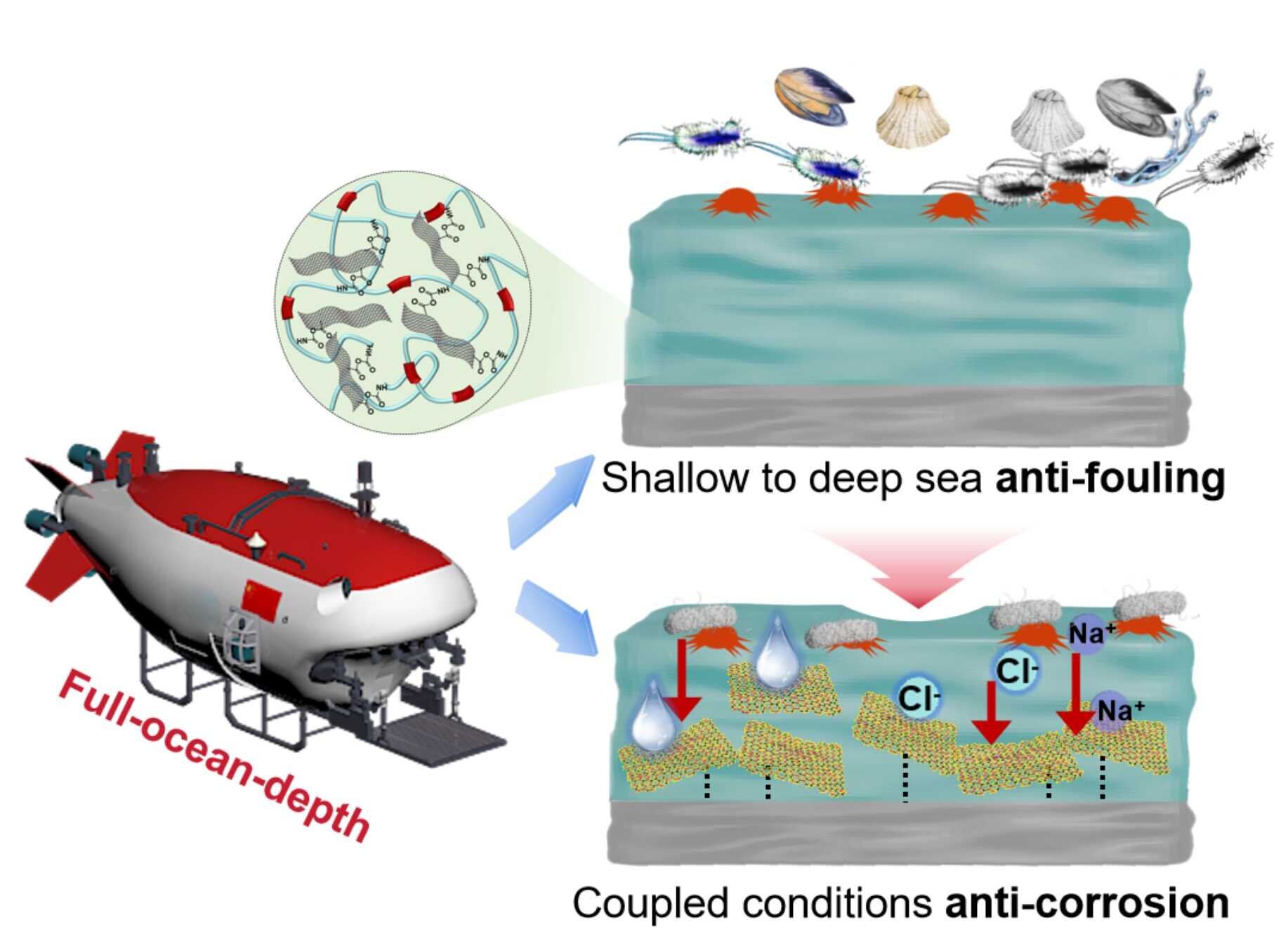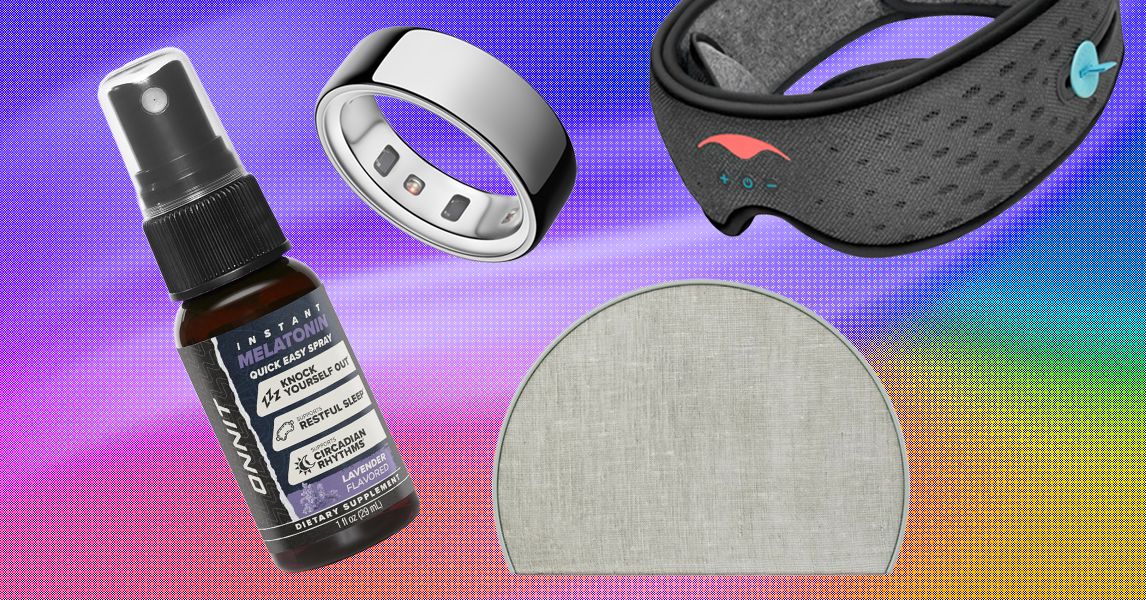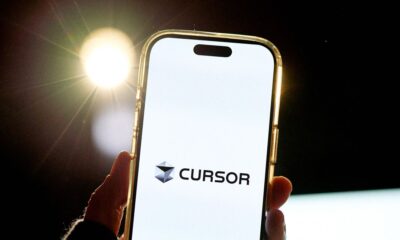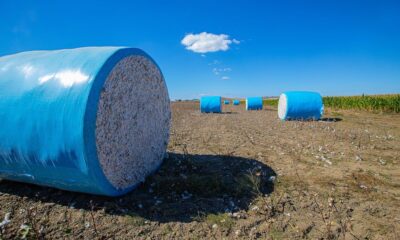Tech
Deep-sea coating offers antifouling and anticorrosion protection in extreme environments

A research team from the Ningbo Institute of Materials Technology and Engineering (NIMTE) of the Chinese Academy of Sciences (CAS), has developed a new integrated poly(oxime-urethane) (PUDF) coating tailored for full-ocean-depth use. The material delivers antifouling and anticorrosion performance for marine engineering applications. The study was recently published in ACS Nano.
The deep sea has emerged as a frontier for marine exploration, but as marine engineering operations expand to full-ocean depths, equipment faces challenges: intense hydrostatic pressure, high salinity, and microbial communities that trigger simultaneous fouling and corrosion—threats that undermine long-term durability.
Conventional multilayer protective systems, however, are vulnerable to interfacial delamination and functional degradation, making them ill-suited for such harsh conditions. This gap has made the development of a single coating that combines synergistic antifouling and anticorrosion protection a critical, long-standing challenge.
To address this, the researchers employed precise molecular design and nanoscale interfacial engineering to create an integrated antifouling and anticorrosion coating based on PUDF. The novel material integrates antibacterial molecules (DFFD) with graphene oxide (GO-COOH) nanosheets, forming a dual-protection system.
The coating exerts its intrinsic antibacterial and antifouling effects by disrupting bacterial purine metabolism and suppressing nucleotide biosynthesis, while the graphene oxide layer provides a physical barrier, blocking corrosive ions and metabolites. This design provides both antifouling and anticorrosion capabilities, even in extreme deep-sea environments.
Experimental results validated the coating’s full-ocean-depth efficacy: Over two months, it prevented the attachment of macrofoulers in the East China Sea (at a depth of 2 meters) and microbial communities in the Philippine Sea (at 7,730 meters). Additionally, the coating withstood prolonged immersion in a simulated environment with high pressure (15 MPa), high salinity, and high bacterial concentration, demonstrating strong anticorrosion performance.
This study provides insights into designing synergistic protection mechanisms for high-performance coatings in extreme environments.
More information:
Peng Zhang et al, Full-Ocean-Depth-Oriented Poly(oxime-urethane) Coating: Construction and Protective Mechanism for Integrated Antifouling and Anticorrosion, ACS Nano (2025). DOI: 10.1021/acsnano.5c09595
Citation:
Deep-sea coating offers antifouling and anticorrosion protection in extreme environments (2025, October 29)
retrieved 29 October 2025
from https://techxplore.com/news/2025-10-deep-sea-coating-antifouling-anticorrosion.html
This document is subject to copyright. Apart from any fair dealing for the purpose of private study or research, no
part may be reproduced without the written permission. The content is provided for information purposes only.
Tech
WIRED’s Tried-and-Tested Best Gifts for Sleep

As someone currently in the gift-buying process, I can confirm it’s easy to become stumped by what to give your loved ones. You want to gift them something they’ll actually use and won’t gather dust in a junk drawer. We all aspire to sleep better, so why not give a gift that helps?
Sleep looks different for everyone. Picking a mattress type, pillows, or even sheets you like can vary significantly from person to person. What you may like, your loved one may not. This is why we’re suggesting picks our Reviews team has found very helpful for all kinds of people and sleep situations.
Speaking of situations, sleep is personal, and you may not feel like gifting your coworker a sound machine. Thankfully, we’ve got gift guides galore, from the best white elephant gifts, best gifts for men (especially the ones you know that insist they don’t need anything, Dad), and the best Advent calendars.
Updated December 2025: We’ve updated the links and prices on this list, and added products from Calm, Cozy Earth, and Lagoon pillows in case you need any last-minute gift ideas.
Tech
Loop Earplugs Offers: Quiet 2, Sweet Dreams and Gift Set Discounts

Loop earplugs are some of the best reusable earplugs you can buy. I personally keep a pair attached to my car keys at all times. As a live music enthusiast that frequently travels to some of the loudest music festivals on the planet, I take earplugs seriously. I want to protect my hearing while also ensuring the sound isn’t muddy and muffled. These are worth it, especially when they’re even cheaper with a Loop earplugs discount code. They’re comfortable and reduce noise without obscuring the music, ensuring that you have an excellent experience without compromising your hearing the next day.
Loop earplugs come with multiple ear tip sizes so you can find the best fit, plus a handy carrying case that’ll keep them clean and easy to find between uses. I also really like how they look in your ears. They’re almost like jewelry. They stay comfortable and secure—I’ve worn mine for over twelve hours at a time, and I love them so much that I’ve purchased them with my own money (even without a Loop earplugs promo code). Your ears will thank you later.
Loop Earplugs Quiet 2 Deals: Protect Your Ears and Reduce Noise
The Quiet 2 are the best Loop earplugs for sleep. They can block out up to 27 dB of noise and they’re made out of soft silicone, so they’ll stay comfortable even if you’re a side sleeper. They’re snug, secure, and small-ear friendly. We also appreciate that they come in multiple colors and that they’re easy to clean with some soap and water.
Save 20% on the Sweet Dreams Gift Set: Loop Dream + Loop Engage 2
This Daily Calm bundle is perfect for everyday noise reduction. You’ll get the Loop Engage 2 Plus, which are basically like noise-canceling headphones for your day-to-day life. They filter out just a little bit of noise—16 dB by themselves, or 25 dB with the included Mute accessory—so you can stay engaged in conversations without getting distracted or overstimulated. The Loop Dream are meant for sleep, with an entirely silicone design and a very low-profile fit, and with a Loop earplugs promo code, they’re 20% off.
20% Off Dreamville Gift Set: Sleep Better, Wake Refreshed
This Dreamville gift set bundle is perfect if you’re looking for Loop earplugs for concerts. It comes with the Loop Experience 2, my favorite earplugs for loud music festivals, in a special Tomorrowland color scheme. Now at 20% off with this Loop earplugs discount code, you’ll also get a connector cord that keeps the earplugs attached around your neck for easy access when you need to pop them in and out. Also included is a pair of Loop Dream earplugs for sleep, which will help you catch some shut-eye even if your festival neighbors are partying until sunrise.
Star Student Gift Set: 20% Off for Focused Study and Sleep
Shop this Loop earplugs sale to get two pairs for 20% off that are great for students. The Loop Quiet 2 helps to dampen the noise around you, like when you’re locked in at the library trying to finish up an essay. And the Loop Engage 2 can help you stay focused during long and lengthy lectures when your fellow students are yapping in the background.
Tired Parent Gift Set: Buy One Dream, Get the Second 50% Off
Do you know some parents in need of better shut-eye? This Tired Parent gift set bundle includes two pairs of Loop Dream in your choice of four different colors, with the second part at 50% off right now. These all-silicone earplugs will assist in both falling and staying asleep—whether you’re trying to muffle a snoring partner, a colicky baby, or the too-loud, battery-operated toys that your kiddo got for their birthday, these will come in handy.
Tech
Here’s What’s in the DOJ’s Epstein File Release—and What’s Missing

Much of the imagery is familiar from previous releases, and includes things like a photo of a stuffed tiger, a photo of a framed Times of London cover of Princess Diana placed at the back of a closet, photos of the many paintings of nude women in Epstein’s townhouse, and framed photos of Epstein associates like Trump and Woody Allen.
Volume 2
The second volume contains 574 photos and one four-second video. Many of the photos feature Epstein and Maxwell in various locations. Several celebrities and politicians also appear in the photos, including actors Chris Tucker and Kevin Spacey, singer Michael Jackson, and Rolling Stones guitarist Keith Richards—none of whom appear in suspicious or compromising positions.
However, Bill Clinton appears multiple times in the second batch of images. In one photo, he is shirtless in a pool with a woman whose identity has been redacted; a photo that appears to have been taken at the same location shows Clinton and Maxwell in the pool. Clinton also appears in multiple photos with women whose identities have been redacted.
Clinton took four trips with Epstein in 2002 and 2003, including a humanitarian trip to Africa and London. During a portion of that trip, he was accompanied by Tucker and Spacey, according to The New York Times.
(Clinton spokesperson Angel Ureña released a statement reading, in part, “They can release as many grainy 20-plus-year-old photos as they want, but this isn’t about Bill Clinton.”)
Dozens of photos feature Jean-Luc Brunel, a modeling agent and close friend of Epstein’s. The photos show Brunel with Epstein and Maxwell in multiple locations, as well as aboard what appears to be Epstein’s infamous private jet. In several images, Maxwell is seen massaging Brunel’s feet and sticking one foot between her breasts.
Brunel was arrested by French authorities in 2020 as part of a sex trafficking and sexual assault investigation into Epstein, and charged with rape of minors over 15 and sexual harassment. Brunel denied any wrongdoing. In 2022, Brunel was found dead, hanged in his jail cell.
Volume 3
The third volume contains several hundred photos. One of those, which appears to have been framed, shows a man who appears to be Prince Andrew posing on his side on the laps of at least four women, whose faces are all redacted. A smiling Maxwell, and a woman whose face is redacted, stand in the background.
Many of the photos, however, may have been printed out as they appeared in digital storage, since the individual photo names, the file extensions, and album names are all visible. Many images with those markers include Clinton, and several were seemingly taken on a group vacation to Thailand that Clinton is alleged to have taken with Epstein and Maxwell. Clinton also joined the couple for at least one leg of a multiple-destination vacation that stopped in China, Paris, and Stockholm, another that stopped in New York, Los Angeles, and London, another trip to Africa and London, and another trip to Morocco. In one photo, Clinton is shown with a woman, whose face is redacted, sitting on Clinton’s lap.
-

 Business7 days ago
Business7 days agoHitting The ‘High Notes’ In Ties: Nepal Set To Lift Ban On Indian Bills Above ₹100
-

 Tech6 days ago
Tech6 days agoFor the First Time, AI Analyzes Language as Well as a Human Expert
-

 Business5 days ago
Business5 days agoKSE-100 index gains 876 points amid cut in policy rate | The Express Tribune
-

 Business1 week ago
Business1 week agoIPO Explained: Meaning, Process, Benefits, Risks
-

 Sports5 days ago
Sports5 days agoJets defensive lineman rips NFL officials after ejection vs Jaguars
-

 Business5 days ago
Business5 days agoStudying Abroad Is Costly, But Not Impossible: Experts On Smarter Financial Planning
-

 Tech1 week ago
Tech1 week agoCursor Launches an AI Coding Tool For Designers
-

 Fashion1 week ago
Fashion1 week agoCAI seeks scrapping of India’s 11% cotton duty to protect industry


















